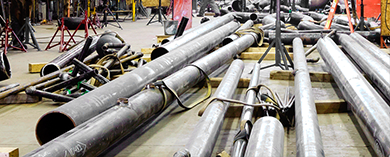
- (03) 5909 8218
- enquiry@fusionweld.com.au
Pipe Spooling Fabrication
August 1, 2014

An in-house solution to a pipe fitting challenge breaks an engineering project into modular sub-assemblies, streamlining the work by fabricating pipe spools in a controlled environment. Access, a function that's at a premium on work sites, is a far more pragmatic concern when set in this manageable space, a logistical and utilitarian factor that prevails until the finalized pipe spool is ready for shipping.
The raw pipes and customized assemblage of fittings required to erect a pipe spooling project have no room in either the tight schedule of a project manager or the claustrophobic confines of an oil refinery. The same can be said of a chemical plant or a mining operation. Cutting to the center of the issue, the piping in these facilities is an intensive labyrinth of interconnecting conduits, and additional assemblies will only bring the work to a grinding halt. Pre-fabrication is the norm in such a massive undertaking, assembling the pipe framework either before or during the industrious erection of the infrastructure. To this end, rolled pipes engineered from specified grades of stainless steel, from metallic or polyurethane-coated alloys are cut to size along with all relevant fixings, the custom flanges and tees, the angled bends and right-angled elbows, that define the pipe spool.
Additional attributes are keyed to the pipe. It may be swaged or threaded, lined with teflon or polyurethane to protect against abrasion and corrosive chemicals. The spooling process then moves on, welding the network of parts together. This stage maneuvers all fittings into their designated positions. The manufacturing of the spool again divides the work into a modular approach, fitting parts temporarily to form a sub-assembly, welding them in place and moving back in the welding operation to assemble more parts to form a larger sub-assembly. The work uses either a spool roll welding procedure, in which case the welder can employ the pipe turning machinery and stay in one spot, or a spool position welding mode of assembly. The latter choice arises when the pipe being worked on is larger than the set clearance limits, forcing the welder to change position to complete the fitting and welding.
These intermediate stages bring the sub-assemblies together in small steps, creating a cycle of fitting and welding to finish the established shape of the spool. The aim of the work is to reduce the steps as much as possible, resolving the job into a high-productivity sequence of fittings that accomplish the set design task within a specified time-frame. The controlled environment allows for an accomplished level of fabrication that would be difficult to achieve on the primary site of construction, an area where interruptions are commonplace. The workplace setting, a fabrication shop environment, facilitates other tasks. A comprehensive test of the integrity of all welds is a simple chore, as is the application of a polyurethane lining or a powder coating. Specialized fabrication companies position themselves as prime candidates in this form of offsite modular pipe manufacture, presenting logistical solutions for cramped construction settings.
Contact Details
Fusion - Weld Engineering Pty Ltd
ABN 98 068 987619
1865 Frankston Flinders Road,
Hastings, VIC 3915
Ph: (03) 5909 8218
Optimized by NetwizardSEO.com.au
Recent Posts
- Compressed Hydrogen Storage Vessels: Material Selection, Design & Australian Standards
- Welding QA/QC in Oil & Gas Pressure Vessel Fabrication – Ensuring Code Compliance
- AS1210 vs ASME VIII Pressure Vessel Code: Key Differences for Australian Projects
- Mitigating Hydrogen-Induced Cracking in Pressure Vessels: Engineering and Material Strategies
- Storage Tank Solutions Australia: Field-Erected, Prefabricated & Self-Bunded Explained
- Reducing Environmental Risks: Self-Bunded Tanks in Australian Oil & Gas Operations
- Precision in Production: How Pressure Vessels Are Manufactured for Industrial Safety
- Shell & Tube Heat Exchangers: Improve Thermal Control & Energy Recovery in Petrochemical & Pharmaceutical Plants
- In-Service Inspection for Compressed Air Receivers for Power Plant Shutdown Prevention
- Power Plant Pipe Spooling Fabrication – Get Rapid, Code-Compliant Spools Ready for Installation
- Field Erected Tanks: Safe, Reliable On-Site Fuel Storage Solutions in Australia
- Custom Pressure Vessel Fabrication for Flammable Gases
Posts 2025
- Compressed Hydrogen Storage Vessels: Material Selection, Design & Australian Standards
- Welding QA/QC in Oil & Gas Pressure Vessel Fabrication – Ensuring Code Compliance
- View all articles…
Posts 2024
- Large Process Vessels: Optimising the Design for Maximum Efficiency [2025]
- Pressure Equipment Management System Installation: Detect Equipment Faults Early
- View all articles…
Posts 2023
- Pressure Piping System Inspection: A Gift of Safety for the Holidays
- Deaerator Inspections by Fusion-Weld Engineering and How They Reduce System Downtime
- View all articles…
Posts 2022
- How Fusion Weld Keeps Up With AS-NZS ISO 9001:2008 Standard
- Boiler Equipment Safety Inspection During the Summer Season
- View all articles…
Posts 2021
- Avoid These Factors and Practices that Contribute to Sealing Damage in Pressure Vessels
- Do's And Don'ts Of Industrial Boiler Inspection And Maintenance From Fusion-Weld
- View all articles…
Posts 2020
- What are the Risks and Hazards Involved in Pressure Vessel Equipment?
- How to Know if Your Pressure Equipment Needs Repair or Replacement?
- View all articles…
Posts 2019
- Factors that Contribute to Pressure Vessel Failure
- Pressure Vessel Regulations in Australia: What are the Mandatory Requirements?
- View all articles…
Posts 2018
- Pros and Cons of Spherical vs. Cylindrical Pressure Vessels
- What are the Different Hazard Levels in Pressure Vessels?
- View all articles…
Posts 2017
- Transportable Pressure Vessels: The Importance of Inspection and Safety Checks
- Fracture Mechanics and Stress Analysis of Cracks in Pressure Vessels
- View all articles…
Posts 2016
Posts 2015
- What Are Deaerators & Feedwater Vessels?
- Precautions and Safety for Compressed Air Receiver Vessels
- View all articles…
Posts 2014
- Demonstrating In-process Inspection Procedures
- Static Grounding Practices and Standards
- View all articles…